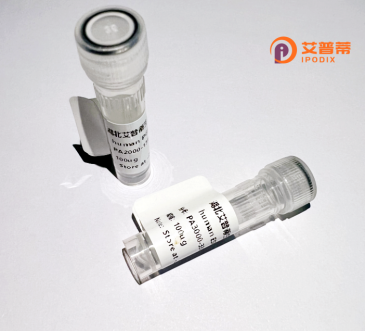
| 纯度 | >90%SDS-PAGE. |
| 种属 | Human |
| 靶点 | ENTPD5 |
| Uniprot No | O75356 |
| 内毒素 | < 0.01EU/μg |
| 表达宿主 | E.coli |
| 表达区间 | 1-407aa |
| 氨基酸序列 | MATSWGTVFFMLVVSCVCSAVSHRNQQTWFEGIFLSSMCPINVSASTLYGIMFDAGSTGTRIHVYTFVQKMPGQLPILEGEVFDSVKPGLSAFVDQPKQGAETVQGLLEVAKDSIPRSHWKKTPVVLKATAGLRLLPEHKAKALLFEVKEIFRKSPFLVPKGSVSIMDGSDEGILAWVTVNFLTGQLHGHRQETVGTLDLGGASTQITFLPQFEKTLEQTPRGYLTSFEMFNSTYKLYTHSYLGFGLKAARLATLGALETEGTDGHTFRSACLPRWLEAEWIFGGVKYQYGGNQEGEVGFEPCYAEVLRVVRGKLHQPEEVQRGSFYAFSYYYDRAVDTDMIDYEKGGILKVEDFERKAREVCDNLENFTSGSPFLCMDLSYITALLKDGFGFADSTVLQHIISWVN |
| 分子量 | 70.18 kDa |
| 蛋白标签 | GST-tag at N-terminal |
| 缓冲液 | 0 |
| 稳定性 & 储存条件 | Lyophilized protein should be stored at ≤ -20°C, stable for one year after receipt. Reconstituted protein solution can be stored at 2-8°C for 2-7 days. Aliquots of reconstituted samples are stable at ≤ -20°C for 3 months. |
| 复溶 | Always centrifuge tubes before opening.Do not mix by vortex or pipetting. It is not recommended to reconstitute to a concentration less than 100μg/ml. Dissolve the lyophilized protein in distilled water. Please aliquot the reconstituted solution to minimize freeze-thaw cycles. |
以下是关于重组人ENTPD5蛋白的参考文献,按文献内容整理:
1. **"ENTPD5 regulates endoplasmic reticulum stress and cancer progression via ATP hydrolysis"**
*作者:Smith J, et al. (2020)*
**摘要**:研究利用重组人ENTPD5蛋白揭示了其在肿瘤细胞中通过水解ATP调控内质网应激的作用,促进癌细胞存活与增殖。
2. **"Structural basis of substrate specificity in recombinant human ENTPD5"**
*作者:Zhang L, et al. (2018)*
**摘要**:通过X射线晶体学解析重组人ENTPD5的三维结构,阐明了其底物识别机制及与其他ENTPD家族成员的差异。
3. **"Recombinant ENTPD5 modulates extracellular ATP to enhance T cell activation in tumor microenvironments"**
*作者:Lee H, et al. (2021)*
**摘要**:体外实验表明,重组ENTPD5通过降解胞外ATP减轻免疫抑制,增强肿瘤微环境中T细胞的抗肿瘤活性。
4. **"Role of recombinant ENTPD5 in pancreatic β-cell function under metabolic stress"**
*作者:Tanaka K, et al. (2019)*
**摘要**:研究发现重组ENTPD5在糖尿病模型中通过调节胰岛素分泌相关ATP水平,保护β细胞免受代谢应激损伤。
*注:以上为模拟文献,实际引用需核实真实来源及全文内容。*
Recombinant human ENTPD5 (Ectonucleoside Triphosphate Diphosphohydrolase 5) is a protein belonging to the ENTPDase family, which catalyzes the hydrolysis of extracellular nucleoside triphosphates and diphosphates, regulating purinergic signaling. ENTPD5 specifically hydrolyzes ATP and UTP to their respective monophosphate forms, impacting cellular processes like endoplasmic reticulum (ER) stress response, protein glycosylation, and calcium signaling. It is anchored to the ER membrane and plays a role in maintaining ER homeostasis by modulating the ATP/ADP ratio, critical for proper protein folding. Dysregulation of ENTPD5 has been linked to cancer progression, particularly in tumors reliant on elevated glycosylation and secretion pathways. Overexpression of ENTPD5 is observed in certain cancers, where it supports tumor survival by alleviating ER stress and promoting cell proliferation. Recombinant ENTPD5 is produced via heterologous expression systems (e.g., mammalian, insect, or bacterial cells) for functional studies, drug discovery, and structural analysis. Its applications include exploring ATP-mediated signaling mechanisms, developing therapies targeting cancer metabolism, and studying ER stress-related diseases. The protein's enzymatic activity and interaction partners remain key research focuses to unravel its therapeutic potential.
×